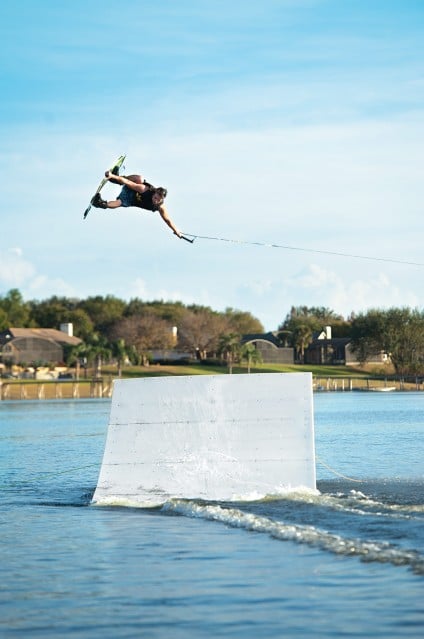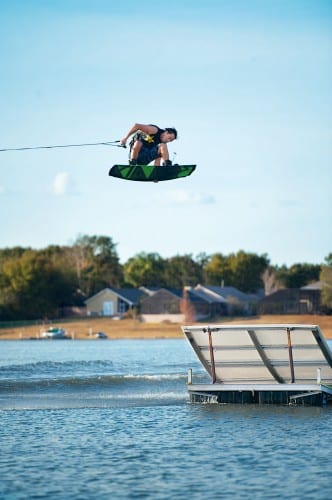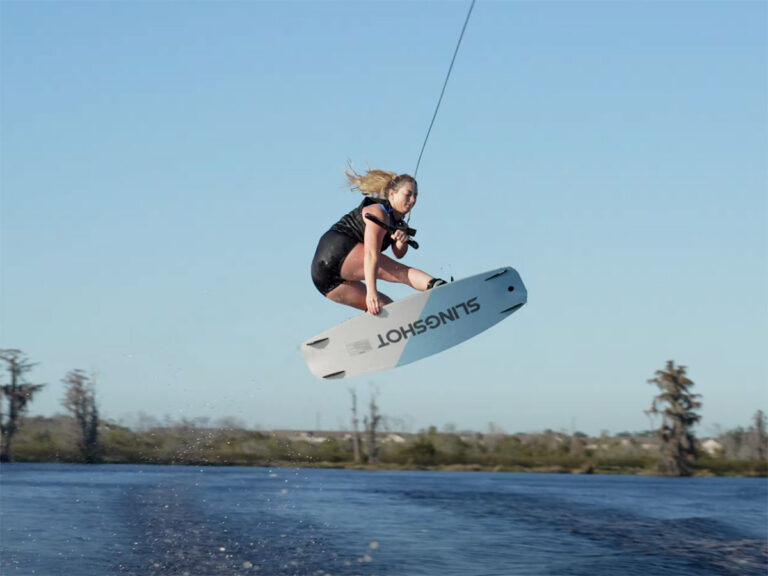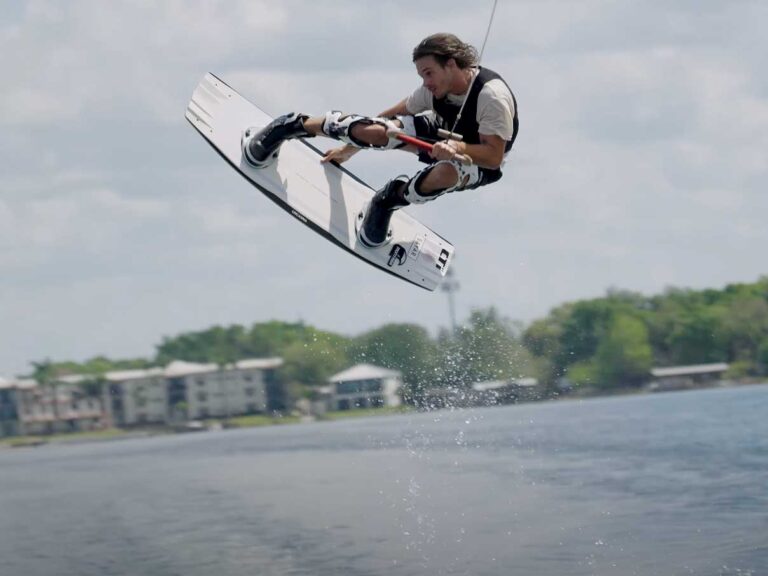
Words: Chad Sharpe Photos: Bill Doster
Hitting a kicker is like no other feeling in wakeboarding. Sure double-ups send you big, but nothing will take your riding as high and as far as the kicker. After all, would you rather do a 20-foot indy glide or a 100-foot indy glide? In addition to making every trick bigger and better-looking, the kicker is also a great teaching tool because its extra boot gives you more time to work on the mechanics of a trick. In this wakeboard how to, learn to dial in your kicker fundamentals so you can not only take your current list of tricks to stunning new heights but also unlock more of the moves that have eluded you off the wake.

Soar
It doesn’t get any bigger than a glide off the kicker.
Use It All Look at any kicker and you’ll see skid marks running diagonally across its face, from just inside the bottom corner to just inside the opposite top corner. Using all of the kicker’s width yields consistent line tension, which will result in more control, added boot and softer landings.
Feel It Out First While you’ll eventually want to travel across the face of the kicker, you should simply feel it out with your first hits. Don’t take an aggressive edge in and don’t worry about getting a ton of pop. Just ride over it a few times to find out what the kick is going to be like.
Touch Down Terrific You’re coming down from a lot higher and you don’t have the second wake to cushion your impact, so landings off the kicker are serious business. Don’t put your landing gear straight out. Instead, land in a crouched position, absorbing the impact with your legs. Also, there’s no shame in dropping to your butt if you come down too hard.
Minimize Mishaps If something goes wrong in the air, I try to get off my feet and either dive into the water or take it to my back. I’d much rather absorb a body shot than chance landing out of control on my feet, which can lead to knee injury.
Send an Indy Glide Build a long, progressive edge from the trough of the boat wake through the bottom right corner of the kicker. As you come into the kicker, move your weight more over your front foot and continue your path across the entire face of the ramp. Ride all the way through the top of the kicker and push off a bit at the very top. The kicker will kick your knees up into you, so when the board comes up, grab it indy. When you start to come down, give the handle a little tug, rolling you into landing position.

Spin
Slow down your spins for added style thanks to the extra air time.
Stay Balanced Kickers are slick, so if you’re on your heels or your toes, you’re going to slip out. Hold your edge right up to the kicker’s base, then flatten off at the last second so your weight is centered. Don’t flatten off too early, though, because your line will go slack and you’ll end up with a harder landing and a big jerk from the boat.
Wait for It The kicker is a lot like a wake, only harder. Just like riding the wake, you want to wait for the top of the kicker to pop. While every kicker is different, you typically get the best pop right at the end. In general, the higher up the kicker you wait, the higher and farther you’re going to get booted.
Spin Slow, Grab Long Kickers tend to over-rotate you, so you really want to focus on slowing down your spins. Take advantage of the extra air time by going for your grab early and holding it for as long as possible.
Pick Your Approach Your edge into the kicker will depend on the trick you’re trying. For glides and other tricks where I’m trying to stretch the distance, I use a long, progressive edge because it helps me carry a lot of speed into the kicker. For flips and spins, I take a shorter, snappier cut at the kicker, which gives me a slightly looser line and more maneuverability to make my rotation.
Spin a Melon Frontside 360 For spins like the melon frontside 360, you want to employ a short, snappier edge, so start your approach a few feet from the wake and give it the gas just before you get to the kicker. As a result, your line will loosen a bit when you level off your edge. The kicker will send you into the spin as you come off the top. Go for the grab and start slowly spinning the first 180. Keep an eye on the water as you turn your head into your shoulder and make the handle pass. You will come around blind, so know that the water is coming and prepare for it by getting into a crouched position.

Flip
The natural boot off the kicker will help you expand your inverts.
Drive It Make sure the kicker is angled slightly away from your boat path so you’re not hitting it straight on and you can use more of the ramp. The driver should always drive at a bit of an angle away from the kicker, especially when his rider is in the air. That way, the rider never loses line tension.
Pace Proper One of the great things about the kicker is that you can slow down in order to build your comfort level. It’s not like the wake, which gets mushy as you reduce your speed. Start at 18 to 20 mph so the ramp doesn’t feel as slippery and you’re not hitting it so hard. Gradually, speed up as you get more comfortable. I typically hit the kicker at about 23 to 24 mph, which is similar to how I hit the wake.
Time It Right Perfect timing comes with practice. Your comfort level and consistency will improves as you learn how your edge into and through the kicker works.
Flip an Indy Tantrum Use an edge that’s in between the long, progressive glide edge and the short, snappy 360 edge. Take that medium edge all the way through the kicker, but make sure to center your body weight over your board because you’ll tend to slide out or go early if not. Just like with the wake, the kicker will do a lot of the work, so you don’t need to throw the flip too hard. Wait for the kick and let it send you into the trick, then reach for the grab as the ramp kicks your knees into your chest. Grabbing the board will speed up your flip, so make sure you’re spotting your landing all the way through. If you’re behind, pull the grab harder to speed up your rotation. As you come around, make sure you’re landing evenly over both feet.







